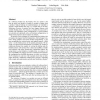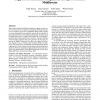AOSD
2008
ACM
14 years 5 months ago
2008
ACM
AOSD
2008
ACM
14 years 5 months ago
2008
ACM
AspectJ was designed as a seamless aspect-oriented extension of the Java programming language. However, unlike Java, AspectJ does not have a safe type system: an accepted binding ...
AOSD
2008
ACM
14 years 5 months ago
2008
ACM
Aspect-oriented programming languages provide new composition mechanisms for improving the modularity of crosscutting concerns. Implementations of such language support use advanc...
AOSD
2008
ACM
14 years 5 months ago
2008
ACM
We have reimplemented the frontend of the extensible AspectBench Compiler for AspectJ, using the aspect-oriented meta-compiler JastAdd. The original frontend was purely object-ori...
AOSD
2008
ACM
14 years 5 months ago
2008
ACM
Program enhancement refers to adding new functionality to an existing program. We argue that repetitive program enhancement tasks can be expressed as patterns, and that the applic...
AOSD
2008
ACM
14 years 5 months ago
2008
ACM
In a software product line, the binding time of a feature is the time at which one decides to include or exclude a feature from a product. Typical binding site implementations are...
AOSD
2008
ACM
14 years 5 months ago
2008
ACM
e instantiation is the transformation of abstract test cases cutable test scripts. Abstract test cases are either created during model based test case generation or are manually d...
AOSD
2008
ACM
14 years 5 months ago
2008
ACM
Many aspect-oriented middleware platforms support run-time aspect weaving, but do not support coordinating distributed changes to a set of aspects at run-time. A distributed chang...
AOSD
2008
ACM
14 years 5 months ago
2008
ACM
We propose test-based pointcuts, a novel pointcut mechanism for AspectJ-like aspect-oriented programming languages. The idea behind the test-based pointcuts is to specify join poi...
AOSD
2008
ACM
14 years 5 months ago
2008
ACM
Aspect-oriented software presents new challenges for the designers of static analyses. Our work aims to establish systematic foundations for dataflow analysis of AspectJ software....







